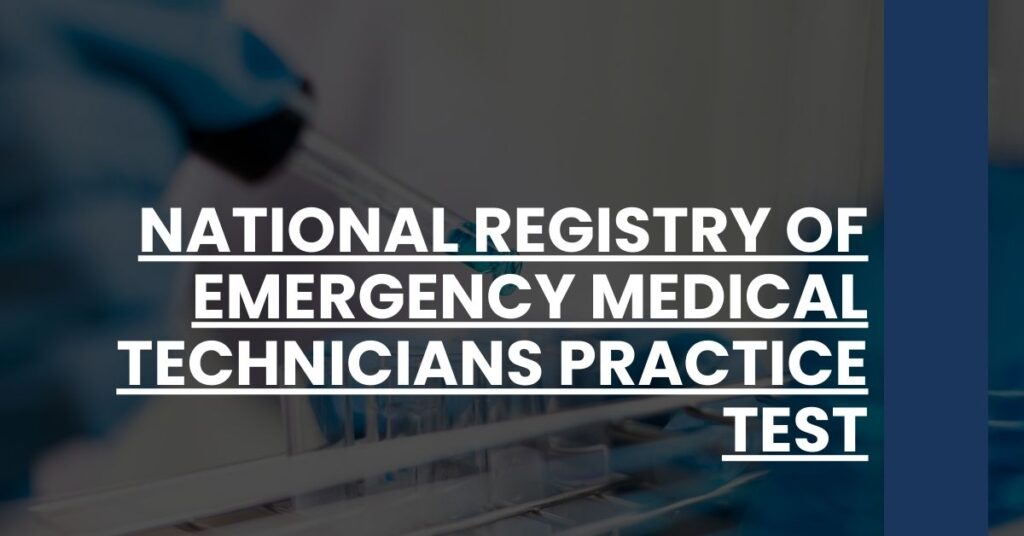Master the National Registry of Emergency Medical Technicians practice test with our expert tips.
- Realistic Simulation: Experience the actual NREMT exam with practice tests that mimic the format and content.
- Answer Explanations: Enhance your learning with detailed explanations for each practice question.
- Score Tracking: Monitor your progress and identify areas for improvement with comprehensive score analysis.
Achieve success on the National Registry of Emergency Medical Technicians practice test.
- Understanding the NREMT Exam
- Types of NREMT Practice Tests
- Content Covered in NREMT Practice Tests
- How Practice Tests Enhance Your Exam Readiness
- Features of a High-Quality NREMT Practice Test
- How to Incorporate Practice Tests into Your Study Routine
- Analyzing Your Performance on Practice Tests
- Navigating Test Anxiety with Practice Tests
- Resources for Finding Quality Practice Tests
- Conclusion: The Path to EMT Certification Success
Understanding the NREMT Exam
For many aspiring emergency medical technicians (EMTs), passing the National Registry of Emergency Medical Technicians (NREMT) exam is an essential step towards a career in emergency medical services. This examination evaluates your grasp of critical skills and knowledge that are crucial for effective performance in emergencies. Understanding the structure and purpose of the NREMT exam not only steers your study strategy but also alleviates much of the anxiety associated with the process.
The Structure of the NREMT Exam
The NREMT exam is a gateway to proving your competency in the pre-hospital environment. It consists of both cognitive (knowledge-based) and psychomotor (skills-based) assessments, covering a range of topics from patient assessment to trauma management. The cognitive exam is adaptive, meaning that it tailors the difficulty of questions based on your previous answers, giving a precise measure of your proficiency.
Why Practice Tests Are Vital
Utilizing National Registry of Emergency Medical Technicians practice tests is akin to having an insider’s view of the exam. They not only familiarize you with the type of questions asked but also give a feel for the pacing and pressure associated with the timed test environment. By repeatedly taking these practice tests, you build muscle memory for the actual exam, maximizing your chances of success.
Types of NREMT Practice Tests
Deciding on the right kind of practice test can be as important as the study material itself. The market offers a spectrum of options, each with its unique benefits and designed to cater to different stages of your preparation.
Free vs. Paid Tests
- Free Practice Tests: These are great for initial self-assessment, to gauge the breadth of your knowledge and the areas that require focus. They are readily available and good starting points.
- Paid Practice Tests: Paid options often provide more depth and come with extras like detailed explanations, tracking progress, and customer support. They simulate the actual exam experience closely, thus are highly recommended for thorough preparation.
Content Covered in NREMT Practice Tests
An effective practice test for the NREMT should comprehensively cover the necessary subject areas, closely mirroring the content of the actual exam. This includes the National EMS Scope of Practice Model, National EMS Education Standards, and a direct connection to the National Registry Practice Analysis.
Key Areas To Expect on Practice Tests
- Airway, Respiration, and Ventilation: Command over this section can quite literally be a life-saver during emergency responses.
- Cardiology and Resuscitation: Know your pulse points, and be ready to jump-start a heart, both metaphorically through studying and literally in the field.
- Trauma: From cuts and bruises to broken bones, be ready for questions that will test your ability to assess and manage various injuries.
- Medical and Obstetrics/Gynecology: Gain insight into handling medical emergencies and providing care in delicate situations such as childbirth.
- EMS Operations: Be familiar with the operational aspects, as efficiency in procedure is just as crucial as medical knowledge.
How Practice Tests Enhance Your Exam Readiness
Practicing regularly with National Registry of Emergency Medical Technicians practice tests not only solidifies your knowledge but also hones your test-taking strategies. Here’s how:
Building Confidence and Competence
- Improves Time Management: Learn to pace yourself effectively to ensure that every question gets its due time.
- Identifies Knowledge Gaps: Recognize which areas require more attention to fortify your knowledge base.
- Boosts Retention: Repetition is the mother of learning, and consistent practice helps in retaining information longer.
Features of a High-Quality NREMT Practice Test
As you search for the best practice tests to prepare for the NREMT exam, keep these attributes in mind:
Elements That Make the Cut
- Varied Question Types: A practice test should challenge you with a mix of question formats — multiple-choice, fill-in-the-blank, scenario-based, and so forth — to prepare you for any test situation.
- In-depth Explanations: Look for tests that provide detailed explanations for correct and incorrect answers to reinforce learning.
- Realistic Simulation: Opt for a practice test that mimics the real NREMT exam environment, including the adaptive nature of the questions where applicable.
A practice test with these qualities, such as those offered by Pocket Prep, ensures that you’re not just practicing but also learning and improving as you go.
How to Incorporate Practice Tests into Your Study Routine
To maximize the effectiveness of your National Registry of Emergency Medical Technicians practice test experience, it’s crucial to integrate these tests into your study schedule strategically.
Crafting Your Study Plan
From the outset, consider practice testing a non-negotiable part of your study routine. Rather than an afterthought, these tests should punctuate your revision, providing critical insights into your readiness and areas for improvement.
- Regular Practice: Schedule practice tests at regular intervals. Start with a baseline test to understand where you stand, and continue with periodic testing to gauge your progress.
- Intersperse with Learning: After each test, take the time to review the answers and learn from your mistakes. Only then should you return to your study materials to reinforce the concepts.
- Increasing Difficulty: As you advance, select practice tests that escalate in difficulty to mimic the cognitive pressures of the actual exam.
Balancing Study and Testing
Use a twofold approach to your studies: first, focus on building knowledge through study materials, then apply this knowledge by tackling practice tests. This iterative process heightens your retention and improves your test-taking skills.
- Study Topic-wise: Dive deep into individual topics. Use reputable resources, like the National EMS Scope of Practice Model, to ensure you’re covering the necessary content.
- Apply Knowledge: After studying a topic, challenge yourself with practice questions in that area to apply what you’ve learned actively.
Analyzing Your Performance on Practice Tests
After completing each practice test, taking the time to analyze your performance is invaluable in refining your study plan and boosting your test-readiness.
Insightful Review
When reviewing your practice test results, it’s about more than just tallying how many you got right or wrong. Deeply engage with each question, understanding the rationale behind the correct answers.
- Track Common Errors: Pay attention to patterns in your mistakes. Do you struggle with certain topics or types of questions?
- Reason Out Missteps: For every wrong answer, identify the gap in your understanding and work to bridge it before your next practice session.
Reflecting on each question helps transform every wrong answer into a valuable learning opportunity, fortifying your knowledge for the real National Registry of Emergency Medical Technicians practice test.
Navigating Test Anxiety with Practice Tests
The National Registry of Emergency Medical Technicians practice test can also be a strategic tool in managing pre-exam nerves. Test anxiety can impair performance, but familiarity breeds confidence.
Calming Techniques
Practice tests provide a safe environment to develop coping mechanisms for stress, allowing you to sit the actual exam with composure and clarity.
- Timing Drills: Take timed practice tests to accustom yourself to working under pressure.
- Visualization: Create a mental image of success, visualizing yourself answering questions with confidence and ease.
By repeatedly simulating the test environment, you chip away at the unknowns that often fuel anxiety, leaving you feeling prepared and calm come test day.
Resources for Finding Quality Practice Tests
Discovering the right National Registry of Emergency Medical Technicians practice test is a significant step in your preparation journey. Here’s where to look:
Reliable Test Banks
- Educational Platforms: Websites like EMS1 are repositories for practice questions and simulation tests.
- Study Guides: Books such as Kaplan’s review book offer a wealth of practice questions and test-taking strategies.
- Online Communities: Engage with platforms where fellow EMT aspirants share insights and recommended test resources.
Selecting a variety of reputable sources will provide a well-rounded practice test experience that reinforces your knowledge from multiple angles.
Conclusion: The Path to EMT Certification Success
Participation in ample National Registry of Emergency Medical Technicians practice tests ushers you towards success. By repetitively exposing yourself to the rigors of the exam, you enhance your knowledge, hone your skills, and build up the endurance required for achieving your goal of EMT certification.
Through consistent practice, analysis, and strategic test-taking, you’ll cultivate not just the expertise to excel on the exam but also the confidence to thrive in your future career as an emergency medical professional. Your dedication to mastering the NREMT practice test is the beacon that guides you through the storm of testing to the calm shores of certification.
Ace the National Registry of Emergency Medical Technicians practice test with our guide on preparation and expert strategies.

